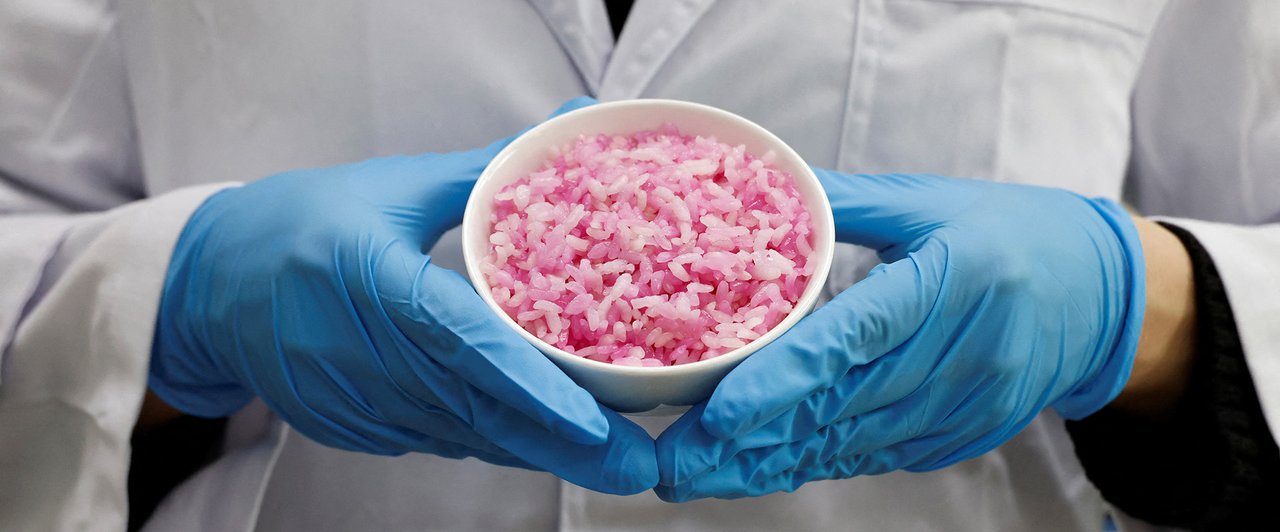Pink rice serves up alternative to carbon-intensive meat
Lab-grown proteins can reduce greenhouse gas emissions but are an expensively acquired taste
By Jessica Rawnsley, Financial Times
The rice is pastel pink. It has a nutty, umami aroma. A slightly brittle texture. But, most surprising of all, each grain contains beef cells. It is a hybrid rice, laced with muscle and fat cells and nurtured in a petri dish to create something novel: part cow, part grain.
Its inventors, academics at Yonsei University in South Korea, wanted to create a sustainable and affordable source of protein — and believe they have done so. According to their calculations, the hybrid rice produces less than a tenth of the carbon of real beef and costs a fraction of the price. Announcing their invention in February, the scientists were evangelical about its potential: “A novel food ingredient that can overcome humanity’s food crisis has been created.”
It is the latest iteration of lab-grown meat to trot on to the burgeoning alternative-protein scene. This encompasses everything from burgers crafted from the humble pea to technologically-engineered meat: plant-based, cultivated or fermented foodstuffs that mimic the appearance, taste and texture of animal products.
To their advocates, alternative proteins are the answer to many of the food industry’s most pernicious problems. Livestock farming contributes 12 per cent of the world’s annual greenhouse gas emissions – more than transport – while also driving habitat destruction and wildlife loss.
But consumer demand looks unlikely to change: by most barometers, demand for meat shows little sign of abating, while the global population continues to swell. Demand for meat is expected to rise 50 per cent by 2050. Innovators hope some of that could be met with kinder, healthier, less polluting food sources.
“The potential is massive,” says Carlotte Lucas, head of industry at Good Food Institute Europe (GFI), an alternative-protein think-tank. “We’re facing so many challenges globally, whether climate change, food security or public health, and alternative-proteins are one of the key solutions.”
A GFI report that made life-cycle assessments of several products found that alternative proteins use between 47 and 99 per cent less land, between 72 and 99 percent less water, and emit between 30 and 90 per cent less greenhouse gas than conventional agriculture. By capturing just 11 percent of the overall protein market by 2035, alternative proteins could cut GHGs on a scale equivalent to decarbonising the entire aviation industry.
In the past few years, hundreds of start-ups have entered the market. Sales of plant-based meat grew 74 percent between 2018 and 2021 as fake steaks, lamb fillets and seafood flushed supermarket shelves. In the heady heydays of 2019, the share price of plant-based food producer Beyond Meat surged 163 per cent on the day it went public, making it the most lucrative launch on Wall Street in two decades.
By contrast, lab-grown meat is a fledgling market, and is yet to reach most consumers. Cell-cultured meat only gained regulatory approval in the US last year. Singapore was the first country to permit its sale in 2020.
And, while the plant-based market appeared to be on an inexorable ascent, it has since stuttered. Sales have slumped in recent years, spooking investors whose risk appetite has been dampened by global economic stagnation and soaring interest rates.
Another problem is the fact that many consumers remain unconvinced by faux meat. Numerous reports and surveys have found that products underwhelmed when it came to taste, texture and nutrition. Companies and scientists are now starting to grapple with this. Impossible Foods and Beyond Meat both relaunched new, ‘meatier’, products this year with simplified ingredient lists.
Research is underway. Professor Anwesha Sarkar, a food scientist at Leeds University, has been exploring how to make dry, plant-based products juicer by adding water rather than calories,or salt. She is sanguine about the feasibility of creating alternative-proteins that are both tastier and healthier. “There was a rush to develop products without understanding why they don’t perform,” she says. “We need to understand first, rather than having an addendum approach: keep on adding salt and fat and someday it will work in terms of taste. That’s not the way it works.”
Then there is the cost. Plant-based products are more expensive to produce than farm-grown meat; cultivated and fermented products even more so. These stubbornly high costs have exacerbated difficulties with scaling production.
What is needed, says Lucas, is government involvement in the form of open research, tax credits, subsidies and funding. That would de-risk the sector and unlock later-stage investment to finance pilot and demo facilities, she argues.
“Governments will play a critical role in enabling the scale-up of the sector,” Lucas says. “We’ve seen a lot of venture capital coming into the space but, [when] scaling up to the next level, you need later-stage investors.”
She points to “bright lights” this year that bode well for the industry — such as Infinite Roots, a German fermentation start-up, securing €50mn in funding rounds. “There’s definitely still traction in the market,” Lucas says. “The transition will happen – it’s a question of speed.”
And to Rosie Wardle, co-founder and partner at Synthesis Capital, a venture capital manager focused on the future of food, the recent downturn in sentiment is a positive. Following the Beyond Meat IPO, there was “a lot of hype in the sector and a lot of over-promising around how quickly the market could grow,” she says. It led to prices becoming over-inflated and hundreds of companies “bandwagon jumping” without offering a differentiated or better product.
“Right now, there’s a lot of consolidation happening – mergers, acquisitions – which, for us, is all good news and very healthy for the sector to really build sustainable foundations for the long-term,” she argues. “If you compare investing now to two years ago, we’re in a much better place because prices are much more rational and founders are focused on the real fundamentals.
“The need for these solutions is more critical than ever. For us, investing in what will be the food industry of tomorrow is one of the most promising investment opportunities out there today — but only if the price is right.”
Alternative-proteins are here to stay. The question is when they will become weekly dinner fare – and just how juicy those burgers will be.


